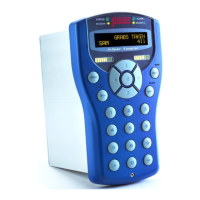Each of the 60 configurable alarms has a defined name or the alarm is not configured. When a
configurable alarm is not configured the title defaults to ‘Empty Slot’. Selecting an empty configurable
alarm begins the process of setting up a new alarm. The setup sequence prompts you for the following
items:
2.7.1 Set Display Text
This is the title of the alarm. You will see this on the alarm page when the alarm is triggered.
2.7.2 Set Source Register
This is the register that is monitored for an alarm condition.
2.7.3 Set Active Register
This register is monitored to see if the alarm itself is currently enabled. A non-zero value makes
that the alarm active. This is useful for UCL programs. Under certain conditions, possibly for a specified
period, you may wish an important alarm to be suppressed.
2.7.4 Invert Active?
If the active register is inverted a zero value in the active register makes the alarm active.
2.7.5 Minimum Value
Minimum register contains a value that the source register is compared against. If it falls below
this value the alarm is activated
2.7.6 Maximum Register
Maximum register contains a value that the source is compared against. If it rises above this
value the alarm is activated.
2.7.7 Invert Rslt?
Normally, when the source register is less than the minimum value or when it is greater than
the maximum value, the alarm is active. If inverted the logic, then says that the alarm is active/on all the
while we are between the minimum and maximum range.
2.7.8 Hysteresis (%)
This is a hysteresis on the minimum and maximum registers and is used to prevent the alarm
toggling active/inactive on a trigger threshold.
2.7.9 Set phases
You are now prompted for whether you want the alarm enabled for each individual application
phase. This flexibility helps to account for most process scenarios.
2.7.10 Alarm Delay
The value, in seconds, between the alarm becoming active and the alarm being triggered in
software. A delay of zero means that the alarm will be triggered immediately.
2.7.11 Send to output
The InSpec alarms have a generic alarm output. Say yes to this question if you want this
specific alarm to generate an output signal. The toggling ‘fleet’ alarm condition toggles the output signal
for [n] seconds. This can be configured via the C_ALARM_FLEET_TIME register. The default is 2
seconds.
2.7.12 Alarm Type
The alarm type is used to indicate the severity of the alarm, and the action that is taken. There
are 4 types - “OFF” / “WARNING” / “CONTROLLED STOP” and “EMERGENCY STOP”.

